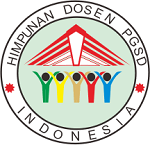KEEFEKTIFAN MODEL PEMBELAJARAN MIND MAPPING DAN PICTURE AND PICTURE BERBANTU MEDIA PUZZLE TERHADAP HASIL BELAJAR SISWA KELAS V SEKOLAH DASAR
DOI:
https://doi.org/10.24114/jgk.v3i1.13845Abstract
Abstract: Effectiveness of Mind Mapping and Picture and Picture LearningModels assisted by Media Puzzle on Learning Outcomes of Class V ElementarySchool Students. This study aims to determine the effectiveness of the MindMapping and Picture and Picture learning models supported by Puzzle media on thelearning outcomes of fifth grade students in science subjects in Doropayung 02Elementary School, Pati Regency. This type of research is an experimental typequantitative research with posttest only control design technique. The population ofthis study was fifth grade students at SD Negeri Doropayung 02 Pati Regency.Retrieving data using observation, documentation and multiple choice tests. Inhypothesis 1 there are differences in student learning outcomes in Heat or HeatTransfer material. In hypothesis 2, it is found that the Mind Mapping learning modelis better than the conventional learning model. In hypothesis 3 it was found that thePicture and Picture learning model was better than the conventional learning model.In hypothesis 4, it is found that the Mind Mapping learning model is better than thePicture and Picture learning model. This shows the use of the Mind Mapping modeland Picture and Picture media-assisted Puzzle effective on the learning outcomes ofstudents of science subjects.Keyword : Mind Mapping, Picture and Picture, Puzzle Media, Learning OutcomesAbstrak : Keefektifan Model Pembelajaran Mind Mapping dan Picture andPicture berbantu Media Puzzle terhadap Hasil Belajar Siswa Kelas V SekolahDasar. Penelitian ini bertujuan untuk mengetahui keefektifan model pembelajaranMind Mapping dan Picture and Picture berbantu media Puzzle terhadap hasil belajarsiswa kelas V pada mata pelajaran IPA di SD Negeri Doropayung 02 KabupatenPati. Jenis penelitian ini adalah penelitian kuantitatif tipe eksperimen dengan teknikposttest only control design. Populasi penelitian ini adalah siswa kelas V di SDNegeri Doropayung 02 Kabupaten Pati. Penggambilan data menggunakan observasi,dokumentasi dan test pilihan ganda. Pada hipotesis 1 terdapat perbedaan hasilbelajar siswa pada materi Perpindahan Kalor atau Panas. Pada hipotesis 2 diperolehbahwa model pembelajaran Mind Mapping lebih baik daripada model pembelajarankonvensional. Pada hipotesis 3 diperoleh bahwa model pembelajaran Picture andPicture lebih baik daripada model pembelajaran konvensional. Pada hipotesis 4diperoleh bahwa model pembelajaran Mind Mapping lebih baik daripada modelpembelajaran Picture and Picture. Hal ini menunjukkan penggunaan model MindMapping dan Picture and Picture berbantu media Puzzle efektif terhadapkemampuan hasil belajar siswa mata pelajaran IPA.Kata Kunci : Mind Mapping, Picture and Picture, Media Puzzle, Hasil BelajarDownloads
Published
2019-08-06
How to Cite
pratami, A. N., Shodiqin, A., & Listyarini, I. (2019). KEEFEKTIFAN MODEL PEMBELAJARAN MIND MAPPING DAN PICTURE AND PICTURE BERBANTU MEDIA PUZZLE TERHADAP HASIL BELAJAR SISWA KELAS V SEKOLAH DASAR. JGK (Jurnal Guru Kita), 3(1), 44–50. https://doi.org/10.24114/jgk.v3i1.13845
Issue
Section
Articles
License
Authors published with the JGK (Jurnal Guru Kita) agree to the following terms:
- Authors retain copyright and grant the journal the right of first publication with the work simultaneously licensed under a Creative Commons Attribution License (CC BY-SA 4.0) that allows others to share the work with an acknowledgment of the work's authorship and initial publication in this journal.
- Authors are able to enter into separate, additional contractual arrangements for the non-exclusive distribution of the journal's published version of the work (e.g., post it to an institutional repository or publish it in a book), with an acknowledgment of its initial publication in this journal.
- Authors are permitted and encouraged to post their work online (e.g., in institutional repositories or on their website) prior to and during the submission process, as it can lead to productive exchanges, as well as earlier and greater citation of published work. (See The Effect of Open Access)


























